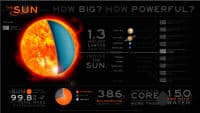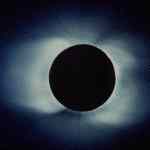
Our Sun is a normal main-sequence G2 star, one of more than 100 billion stars in our galaxy but although The sun may appear to be the largest star in the sky, that’s just because it’s the closest. On a stellar scale, it’s really quite average — about half of the known stars are larger; half are smaller. The largest known star in the universe is UY Scuti, a hypergiant with a radius around 1,700 times larger than the sun. And it’s not alone in dwarfing Earth’s dominant star.
The largest of all
In 1860, German astronomers at the Bonn Observatory first cataloged UY Scuti, naming it BD -12 5055. During a second detection, the astronomers realized it grows brighter and dimmer over a 740-day period, leading astronomers to classify it as a variable star. The star lies near the center of the Milky Way, roughly 9,500 light-years away.
Located in the constellation Scutum, UY Scuti is a hypergiant, the classification that comes after supergiant, which itself comes after giant. Hypergiants are rare stars that shine very brightly. They lose much of their mass through fast-moving stellar winds.
Of course, all stellar sizes are estimates, based on measurements taken from far away.

“The complication with stars is that they have diffuse edges,” wrote astronomer Jillian Scudder of the University of Sussex. “Most stars don’t have a rigid surface where the gas ends and vacuum begins, which would have served as a harsh dividing line and easy marker of the end of the star.”
Instead, astronomers rely on a star’s photosphere, where the star becomes transparent to light and the particles of light, or photons, can escape the star.
“As far as an astrophysicist is concerned, this is the surface of the star, as this is the point at which photons can leave the star,” Scudder said.
If UY Scuti replaced the sun in the center of the solar system, its photosphere would extend just beyond the orbit of Jupiter. The nebula of gas stripped from the star extends even farther out, beyond the orbit of Pluto to 400 times time the Earth-sun distance.
But UY Scuti doesn’t remain stagnant. Scudder pointed out that the star varies in brightness as it varies in radius, with a margin of error of about 192 solar radii. These errors could allow other stars to beat out UY Scuti in the race for size. In fact, there are as many as 30 stars whose radii fit within UY Scuti’s smallest estimated size, so it shouldn’t sit too securely on its throne.
Nor does UY Scuti’s large radius make it the most massive star. That honor goes to R136a1, which weighs in at about 300 times the mass of the sun but only about 30 solar radii. UY Scuti, in comparison, is only about 30 times more massive than the sun.
Title contenders
So which star would take UY Scuti’s place if it weren’t exactly 1,708 solar radii? Here are a few of the stars that might dominate:
- WOH G64, measuring 1,504 to 1,730 solar radii. It is a red hypergiant star in the Large Magellanic Cloud (a satellite galaxy to the Milky Way). Like UY Scuti, it varies in brightness. Some estimates have placed its radius as high as 3,000 solar radii. Variations are due in part to the presence of dust, which affects the brightness of the star and its related radius.
- RW Cephei, at 1,535 solar radii. This star is an orange hypergiant in the constellation of Cepheus, and also a variable star.
- Westerlund 1-26, which comes in at 1,530 to 2,550 solar radii. If the upper estimate is correct, its photosphere would engulf the orbit of Saturn if the star were placed at the center of the solar system. The star changes its temperature but not its brightness.
- KY Cygni, at 1,420 to 2,850 solar radii. It’s a red supergiant in the constellation Cygnus. The upper estimate is considered by astronomers to be dubious due to an observational error, while the lower estimate is consistent with other stars from the same survey, as well as theoretical models of stellar evolution.
- VY Canis Majoris, ranging from 1,300 to 1,540 solar radii. This red hypergiant star was previously estimated to be 1,800 to 2,200 solar radii, but that size put it outside the bounds of stellar evolutionary theory. New measurements brought it down to size. (Some sources still list it as the largest star.)
-
History of The Sun
The Sun is by far the largest object in the solar system. It contains more than 99.8% of the total mass of the Solar System (Jupiter contains most of the rest).
It is often said that the Sun is an “ordinary” star. That’s true in the sense that there are many others similar to it. But there are many more smaller stars than larger ones; the Sun is in the top 10% by mass. The median size of stars in our galaxy is probably less than half the mass of the Sun.

The Sun is personified in many mythologies: the Greeks called it Helios and the Romans called it Sol.
The Sun is, at present, about 70% hydrogen and 28% helium by mass everything else (“metals”) amounts to less than 2%. This changes slowly over time as the Sun converts hydrogen to helium in its core.
The outer layers of the Sun exhibit differential rotation: at the equator the surface rotates once every 25.4 days; near the poles it’s as much as 36 days. This odd behavior is due to the fact that the Sun is not a solid body like the Earth. Similar effects are seen in the gas planets. The differential rotation extends considerably down into the interior of the Sun but the core of the Sun rotates as a solid body.
Conditions at the Sun’s core (approximately the inner 25% of its radius) are extreme. The temperature is 15.6 million Kelvin and the pressure is 250 billion atmospheres. At the center of the core the Sun’s density is more than 150 times that of water.
The Sun’s power (about 386 billion billion mega Watts) is produced by nuclear fusion reactions. Each second about 700,000,000 tons of hydrogen are converted to about 695,000,000 tons of helium and 5,000,000 tons (=3.86e33 ergs) of energy in the form of gamma rays. As it travels out toward the surface, the energy is continuously absorbed and re-emitted at lower and lower temperatures so that by the time it reaches the surface, it is primarily visible light. For the last 20% of the way to the surface the energy is carried more by convection than by radiation.

The surface of the Sun, called the photosphere, is at a temperature of about 5800 K. Sunspots are “cool” regions, only 3800 K (they look dark only by comparison with the surrounding regions). Sunspots can be very large, as much as 50,000 km in diameter. Sunspots are caused by complicated and not very well understood interactions with the Sun’s magnetic field.
A small region known as the chromosphere lies above the photosphere.

The highly rarefied region above the chromosphere, called the corona, extends millions of kilometers into space but is visible only during a total solar eclipse (left). Temperatures in the corona are over 1,000,000 K.
It just happens that the Moon and the Sun appear the same size in the sky as viewed from the Earth. And since the Moon orbits the Earth in approximately the same plane as the Earth’s orbit around the Sun sometimes the Moon comes directly between the Earth and the Sun. This is called a solar eclipse; if the alignment is slighly imperfect then the Moon covers only part of the Sun’s disk and the event is called a partial eclipse. When it lines up perfectly the entire solar disk is blocked and it is called a total eclipse of the Sun. Partial eclipses are visible over a wide area of the Earth but the region from which a total eclipse is visible, called the path of totality, is very narrow, just a few kilometers (though it is usually thousands of kilometers long). Eclipses of the Sun happen once or twice a year. If you stay home, you’re likely to see a partial eclipse several times per decade. But since the path of totality is so small it is very unlikely that it will cross you home. So people often travel half way around the world just to see a total solar eclipse. To stand in the shadow of the Moon is an awesome experience. For a few precious minutes it gets dark in the middle of the day. The stars come out. The animals and birds think it’s time to sleep. And you can see the solar corona. It is well worth a major journey.
The Sun’s magnetic field is very strong (by terrestrial standards) and very complicated. Its magnetosphere (also known as the heliosphere) extends well beyond Pluto.

In addition to heat and light, the Sun also emits a low density stream of charged particles (mostly electrons and protons) known as the solar wind which propagates throughout the solar system at about 450 km/sec. The solar wind and the much higher energy particles ejected by solar flares can have dramatic effects on the Earth ranging from power line surges to radio interference to the beautiful aurora borealis.
Recent data from the spacecraft Ulysses show that during the minimum of the solar cycle the solar wind emanating from the polar regions flows at nearly double the rate, 750 kilometers per second, than it does at lower latitudes. The composition of the solar wind also appears to differ in the polar regions. During the solar maximum, however, the solar wind moves at an intermediate speed.
Further study of the solar wind will be done by Wind, ACE and SOHO spacecraft from the dynamically stable vantage point directly between the Earth and the Sun about 1.6 million km from Earth.
The solar wind has large effects on the tails of comets and even has measurable effects on the trajectories of spacecraft.

Spectacular loops and prominences are often visible on the Sun’s limb (left).
The Sun’s output is not entirely constant. Nor is the amount of sunspot activity. There was a period of very low sunspot activity in the latter half of the 17th century called the Maunder Minimum. It coincides with an abnormally cold period in northern Europe sometimes known as the Little Ice Age. Since the formation of the solar system the Sun’s output has increased by about 40%.
The Sun is about 4.5 billion years old. Since its birth it has used up about half of the hydrogen in its core. It will continue to radiate “peacefully” for another 5 billion years or so (although its luminosity will approximately double in that time). But eventually it will run out of hydrogen fuel. It will then be forced into radical changes which, though commonplace by stellar standards, will result in the total destruction of the Earth (and probably the creation of a planetary nebula).
The Sun’s satellites
There are eight planets and a large number of smaller objects orbiting the Sun. (Exactly which bodies should be classified as planets and which as “smaller objects” has been the source of some controversy, but in the end it is really only a matter of definition. Pluto is no longer officially a planet but we’ll keep it here for history’s sake.)
Search
Planet Distance(000 km) Radius(km) Mass(kg) Discoverer Date Mercury 57,910 2439 3.30e23 Venus 108,200 6052 4.87e24 Earth 149,600 6378 5.98e24 Mars 227,940 3397 6.42e23 Jupiter 778,330 71492 1.90e27 Saturn 1,426,940 60268 5.69e26 Uranus 2,870,990 25559 8.69e25 Herschel 1781 Neptune 4,497,070 24764 1.02e26 Galle 1846 Pluto 5,913,520 1160 1.31e22 Tombaugh 1930 More detailed data and definitions of terms can be found on the data page.
More about the Sun
-
- more Sun images
- from NSSDC
- Stanford Solar Center
- Yohkoh Public Outreach Project, lots of good info, images and movies
- The University of Michigan Solar and Heliospheric Research Group’s Web Space for Kids and Non-Scientists
- Solar Data Analysis Center
- Elemental abundances in the Sun
- National Solar Observatory / Sacramento Peak Image Index
- more info and links about sunspots
- historical info about sunspots
- Virtual Tour of the Sun by Michael Berger
- The Sun: a Pictorial Introduction, a slide set by P. Charbonneau and O.R. White
- The HK Project
- Ulysses Home Page
- Spartan 201, NASA’s mission to explore the Sun’s corona
- IACG Campaign IV: including lots of good references
- Lives and Deaths of Stars; notes by Nick Strobel of the University of Washington
- ESA/NASA’s SOHO – Solar and Heliospheric Observatory home page
- articles by John Bahcall, many focusing on the solar neutrino problem
- animals and birds think it’s time to sleep
- Interview with Sol by Robert J. Nemiroff
Open Issues
- Is there a causal connection between the Maunder Minimum and the Little Ice Age or was it just a coincidence? How does the variability of the Sun affect the Earth’s climate?
- Since all the planets except Pluto orbit the Sun within a few degrees of the plane of the Sun’s equator, we know very little about the interplanetary environment outside that plane. The Ulysses mission will provide information about the polar regions of the Sun.
- The corona is much hotter than the photosphere. Why?
Interesting Facts about the Sun
-
- The Sun is one of the millions of stars in the solar system. It is, however, larger than most (although not the biggest) and a very special star to us. Without the Sun there would be absolutely no life on Earth.
- The Sun is 870,000 miles (1.4 million kilometers) across. This is so big it is hard to imagine, but it would take more than one million Earths to fill the size of the Sun!
- The Sun is so big it takes up 99% of the matter in our solar system. The 1% left over is taken up by planets, asteroids, moons and other matter.
- The Sun is about 4.5 billion years old. It is thought to be halfway through its lifetime. Stars get bigger as they get older.
- As the Sun ages, it will get bigger. When this happens, it will consume some of the things close to it, and this includes Mercury, Venus and maybe even Earth and Mars. Luckily this is billions of years in the future.
- The Sun is the centre of the solar system.
- The Sun is 92.96 million miles (149.6 kilometers) away from Earth.
- The Sun is made of a ball of burning gases. These gases are 92.1% hydrogen and 7.8% helium.
- The sunlight we see on Earth left the Sun 8 minutes ago. This is the length of time it takes for the light to travel the distance between the Sun and the Earth.
- When the moon goes around the Earth, it sometimes finds itself between the Earth and the Sun. This is called a solar eclipse and makes the Earth dark whilst the moon shuts out most of the Sun’s light. This only lasts for a couple of hours while the moon continues its rotation and moves out of the way of the sun.
- In ancient astronomy, it was thought that the Sun moved. People believed that the Earth stayed still and the Sun rotated around it.
- About 2000 years ago some began to think it was the Sun that stays still whilst the planets make a path around it. This only became an accepted theory around the 1600s when Isaac Newton proposed the sun-centric solar system.
- The Sun is almost a perfect sphere. It is the closest thing to a sphere found in nature with only a 6.2 mile (10 kilometres) difference between its vertical and horizontal measurements.
- The Sun’s core is extremely hot! An unthinkable 13,600,000 degrees Celcius!
- The Sun has a very big magnetic field. It is the most powerful magnetic field in the whole solar system. This field is regenerating itself, but scientists are unsure how.
- The Sun produces solar winds. These are a stream of particles from the Sun that stream out into space. This is why planets atmospheres are so important. They protect the planet from these solar winds.
- The Sun rotates but not as Earth does. On Earth, the planet is rotating at the same speed no matter where you are. The Sun does not rotate like a solid object and is spinning faster at its equator than it is at its poles. It is complicated to say how fast the Sun is spinning but depending whereabouts on the Sun you are looking at it takes between 24 and 38 days to spin around.
- The Sun has been both worshipped and feared throughout history by a variety of cultures.
-
